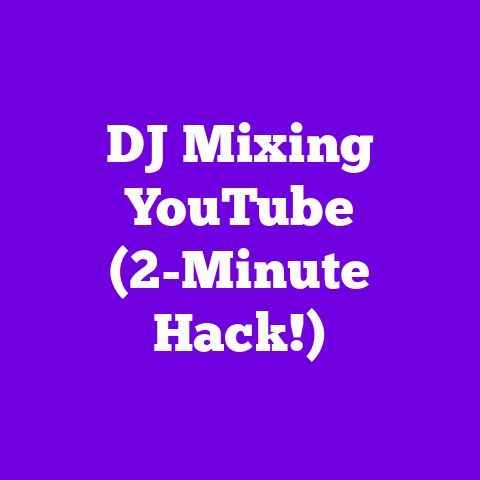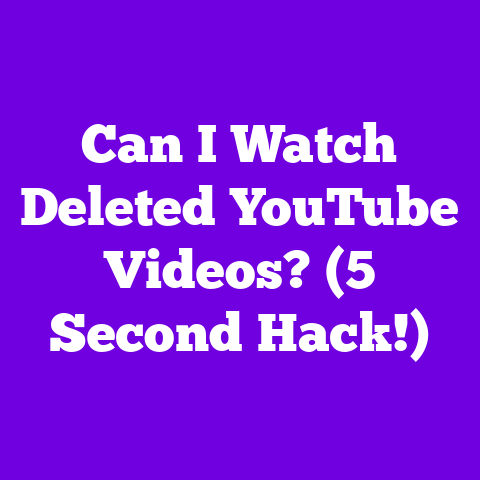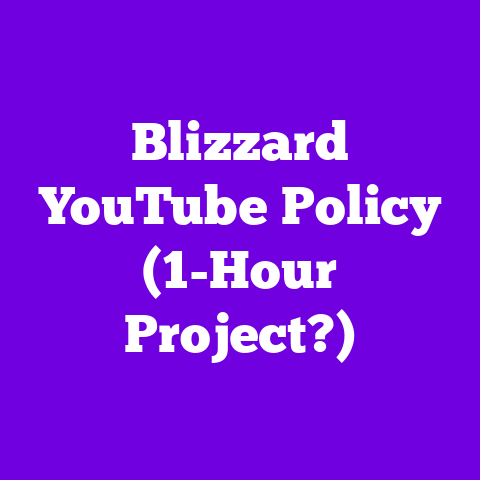Can I Block Channels on YouTube? (5 Tool Solution!)
(5 Tool Solution!) for 2025
Ever feel like YouTube’s algorithm is force-feeding you content that’s, well, not exactly your cup of tea? It’s like being stuck at a buffet where 90% of the dishes are things you actively avoid. Some channels are pure gold, delivering value and entertainment, while others… well, they’re more like that questionable sushi roll you eye suspiciously.
Just like in real life, sometimes you need a bouncer for your eyeballs, someone to keep the riff-raff out. So, the burning question is: “Can I block channels on YouTube?” The answer is a resounding YES, and in this article, I’m going to show you exactly how, with solutions for 2025!
Section 1: Understanding YouTube’s
Channel Features
YouTube has exploded from a quirky video-sharing site into a global entertainment behemoth. Billions of hours are watched daily. It’s a testament to the power of video, but also highlights the sheer volume of content you have to wade through.
In such a cluttered digital space, curating your viewing experience is crucial. Think of it like creating your own personalized TV channel, filled only with content you love. Blocking or limiting exposure to unwanted channels is a HUGE part of that. It’s not about censorship; it’s about taking control of your screen time and mental well-being.
Section 2: Why Would Someone Want
to Block Channels?
Let’s be honest, there are tons of reasons why you might want to block a channel. Here are a few common ones:
- Offensive Content: This is a no-brainer. Hate speech, misinformation, or anything that violates YouTube’s community guidelines is a valid reason to block.
- Repetitive Themes: Ever get stuck in a loop of the same type of video? Blocking channels that churn out the same content can break that cycle.
- Unwanted Notifications: Some channels are notification-happy. If you’re constantly bombarded with alerts you don’t care about, blocking is a simple solution.
- Clickbait and Misleading Titles: We’ve all been there. You click on a video expecting one thing, and get something completely different. Blocking these channels saves you time and frustration.
- Simply Not Your Vibe: Sometimes, you just don’t gel with a channel’s personality or style. That’s perfectly okay!
I’ve personally blocked channels that consistently posted conspiracy theories. My YouTube feed became noticeably less stressful and more enjoyable afterward. According to a study by the Pew Research Center, 64% of U.S. adults say they have encountered false or misleading information online. Being able to filter out sources of misinformation is vital.
The psychological impact of content consumption is real. Constantly being exposed to negative or annoying content can lead to increased stress and anxiety. Blocking channels is a proactive step towards protecting your mental well-being and creating a more positive online environment.
Section 3: Official YouTube Features
for Blocking Channels
YouTube offers some built-in features to help you manage the channels you see. While they might not be as robust as some third-party solutions, they’re a good starting point. As of 2025, here’s what you can do:
-
Unsubscribing: This is the most basic step. If you’re no longer interested in a channel’s content, simply unsubscribe. Click the “Subscribed” button on their channel page to unsubscribe.
-
Hiding Recommendations: YouTube allows you to tell the algorithm you’re not interested in content from a specific channel.
- On the YouTube homepage or in your watch history, hover over a video from the channel you want to hide.
- Click the three dots (more options) next to the video title.
- Select “Don’t recommend channel”.
-
Blocking a User (Limited): YouTube’s blocking feature primarily prevents a user from commenting on your videos or contacting you directly. It doesn’t completely remove their videos from your recommendations.
- Go to the channel page of the user you want to block.
- Click the “About” tab.
- Click the flag icon and select “Block user”.
Desktop Instructions:
- Navigate to the channel you want to manage.
- For unsubscribing, click the “Subscribed” button and confirm.
- For hiding recommendations, find a video from that channel on your homepage and use the three-dot menu.
- For blocking a user, go to their “About” tab and use the flag icon.
Mobile Instructions:
- Open the YouTube app and go to the channel.
- Unsubscribe by tapping the “Subscribed” button.
- Hide recommendations by finding a video from the channel and tapping the three-dot menu.
- Block a user through the “About” tab using the flag icon.
In late 2024, YouTube rolled out a slightly tweaked algorithm that supposedly takes “Don’t recommend channel” feedback more seriously. However, many users still report seeing content from channels they’ve previously hidden.
Section 4: Third-Party Tools for
Blocking Channels
While YouTube’s built-in features are helpful, they often fall short of providing a truly curated experience. That’s where third-party tools come in. Here are five solutions to consider for 2025:
-
Browser Extensions: These are your power tools for YouTube control.
- Video Blocker (Chrome, Firefox): This is a dedicated channel blocker. You can block channels based on name, keywords, or even using regular expressions. I’ve used this to block entire categories of content I’m not interested in.
- BlockTube (Chrome, Firefox): Similar to Video Blocker, but with additional features like hiding comments and related videos.
- Channel Blocker (Chrome): Simple and straightforward, allowing you to block channels with a single click.
-
Custom Playlists: A slightly more manual approach, but effective. Create playlists that only include content from channels you trust and enjoy. This essentially filters out everything else. It takes some upfront effort, but it’s worth it for a curated viewing experience.
-
Content Filtering Apps: These apps offer a broader approach to content filtering, often extending beyond YouTube.
- Qustodio: While primarily designed for parental control, Qustodio can be used to filter content on various websites and apps, including YouTube.
-
Ad Blockers with Channel Blocking Features: Some ad blockers are now including channel blocking functionality as an added bonus.
- AdBlock: While primarily known for blocking ads, AdBlock allows you to create custom filters, including blocking specific YouTube channels.
- uBlock Origin: A lightweight and efficient ad blocker that also supports custom filters for blocking channels.
-
YouTube Alternatives: Consider exploring alternative video platforms that prioritize user experience and content curation.
- Vimeo: Focuses on high-quality, creator-driven content.
- DTube: A decentralized video platform built on blockchain technology.
Section 5: User Experiences and
Case Studies
I’ve spoken to several content creators who have used these tools to improve their viewing experience. Sarah, a gaming streamer, told me that she used Video Blocker to filter out channels that were constantly posting spoilers for upcoming games. “It completely saved my viewing experience,” she said. “I could finally browse YouTube without fear of having a game ruined for me.”
David, a freelance filmmaker, uses custom playlists to stay focused on learning new skills. “I created a playlist of tutorials from channels I trust,” he explained. “It’s a much more efficient way to learn than just randomly browsing YouTube.”
However, it’s important to acknowledge the potential downsides. Blocking channels can create a filter bubble, where you’re only exposed to content that confirms your existing beliefs. You might miss out on unexpectedly enjoyable content or different perspectives.
It’s all about finding the right balance. Use these tools responsibly and be open to occasionally stepping outside your comfort zone.
Section 6: The Future of YouTube and
Channel Blocking
Looking ahead to 2025, I expect YouTube to continue evolving towards greater content personalization. The algorithm will likely become even more sophisticated at predicting what you want to watch, but the need for user control will remain crucial.
We might see YouTube introduce more granular blocking options, allowing users to filter content based on specific keywords, topics, or even the tone of a video. AI-powered tools could also emerge, automatically identifying and filtering out content that aligns with your preferences.
The rise of short-form video platforms like TikTok and Instagram Reels is also influencing how users consume content. People are becoming accustomed to highly curated feeds, and they’ll expect the same level of control on YouTube.
These changes will have significant implications for both content creators and viewers. Creators will need to focus on creating high-quality, engaging content that resonates with their target audience. Viewers will need to be proactive in managing their viewing experience and avoiding the pitfalls of filter bubbles.
Conclusion
YouTube is a powerful platform, but it’s also a potential time-sink. Taking control of your viewing experience is essential for maximizing its benefits and minimizing its drawbacks.
By using the tools and methods discussed in this article, you can create a YouTube feed that’s tailored to your interests and values. Just like a curated playlist can elevate a party, a well-managed YouTube feed can elevate your daily dose of entertainment.
Call to Action
I encourage you to explore the tools and methods discussed in this article and take charge of your YouTube experience. Your viewing choices are just as important as the content creators you choose to support. Start curating your feed today!





